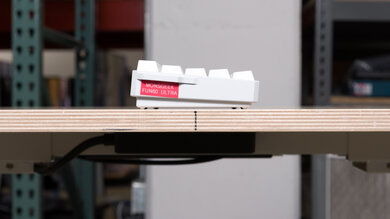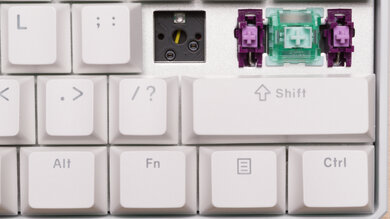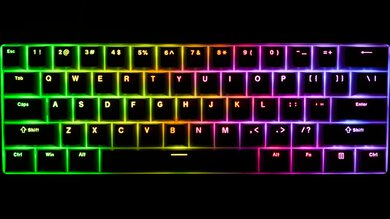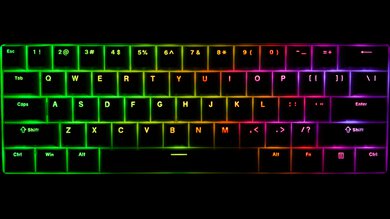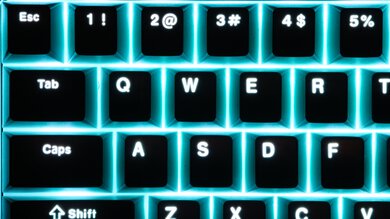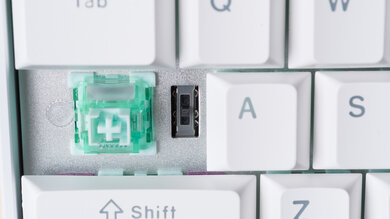The MonsGeek FUN60 Ultra is a compact gaming keyboard in MonsGeek's wider FUN60 series. This keyboard is available with wired-only or tri-mode wireless connectivity and a hot-swappable PCB with either Hall effect or TMR (tunnel magnetoresistance) sensors. TMR sensors are an emerging technology for keyboards and are advertised as having better precision and lower power draw compared to Hall effect sensors. An additional advantage of the TMR configuration is that it lets you swap out and use both magnetic and standard mechanical switches, a feature MonsGeek calls "MagMech". Comparatively, the Hall effect configuration of this keyboard is only compatible with magnetic switches. This keyboard's software allows you to change expected actuation settings as well as more advanced settings, such as Rapid Trigger, SOCD, DKS, and mod tap. For more information about these settings, see the Configuration Software section.
We bought and tested a wireless configuration with TMR sensors. For a comparison between different configurations, see the Differences Between Variants section.
Our Verdict
The MonsGeek FUN60 Ultra is an excellent gaming keyboard. It has outstanding raw gaming performance and a high-quality aluminum case, pre-lubed switches and stabilizers, and a decent amount of dampening material inside the case. It's available in wired or wireless configurations with both 2.4GHz and Bluetooth connectivity, which remains relatively rare for high-performance gaming keyboards. Its software also provides solid customizability with expected actuation options as well as more advanced options, including DKS (dynamic keystrokes), mod tap, and SOCD, which can give you an edge in some gaming scenarios, such as tap strafing in FPS titles.
Excellent build quality
Superb raw performance.
Supports a maximum polling rate of 8000Hz.
Web-based or downloadable software supports advanced features like Rapid Trigger, SOCD, and DKS.
Somewhat stiff-feeling tray mount.
The MonsGeek FUN60 Ultra isn't designed explicitly for office work, but can still be a great choice depending on your needs. Its compact 60% layout is missing a function row, arrow keys, and a Numpad, which may be an issue for some workflows. That said, it has excellent build quality and supports wireless connectivity using a 2.4 GHz receiver or Bluetooth. It also has robust software if you'd like to remap keys or change other settings. Despite its all-aluminum construction, it's also reasonably quiet, thanks to dampening material inside the case and under the spacebar.
Excellent build quality
Supports multi-device pairing over Bluetooth.
Somewhat stiff-feeling tray mount.
No typing angle incline options.
You need to remove the Caps Lock keycap to access the connectivity/OS compatibility switch.
The MonsGeek FUN60 Ultra is decent for mobile or tablet use. It has excellent build and typing quality out of the box, and you can connect it wirelessly via Bluetooth with up to three devices simultaneously. It also has a fairly compact 60% build, although it's quite heavy for its size due to its aluminum case, and its fairly tall profile makes it a little bulky to be stowed in a backpack or laptop bag.
Excellent build quality
Supports multi-device pairing over Bluetooth.
You need to remove the Caps Lock keycap to access the connectivity/OS compatibility switch.
Heavy.
While not designed specifically with this use in mind, the MonsGeek FUN60 Ultra is an impressive keyboard for programming. It has excellent build quality with a solid aluminum case and pre-lubed switches and stabilizers. It's also fairly quiet, despite its aluminum case, and it has full RGB backlighting, which is helpful if you prefer working in lower-light rooms. It's worth noting that its compact size may not suit all coding workflows, as it's missing a function row and a navigation cluster. That said, if you don't mind using layers, it has robust web-based or downloadable software that you can use to remap keys and change other expected settings.
Excellent build quality
Supports multi-device pairing over Bluetooth.
Somewhat stiff-feeling tray mount.
No typing angle incline options.
You need to remove the Caps Lock keycap to access the connectivity/OS compatibility switch.
The MonsGeek FUN60 Ultra is acceptable for an entertainment or home theater PC setup. It has excellent build quality and connects wirelessly, either with its included 2.4 GHz receiver or via Bluetooth. It also has RGB backlighting with shine-through legends for good visibility in the dark. Unfortunately, it lacks dedicated media keys, and it's quite heavy for its size due to its solid aluminum case.
Supports multi-device pairing over Bluetooth.
No dedicated media keys.
Heavy.
The MonsGeek FUN60 Ultra has superb raw performance. It offers remarkably low and consistent single-key and multi-key latency performance. It also has superb adjustable input with very small dead zones, allowing for extremely quick and accurate initial and follow-up inputs, making it extremely well-suited for competitive gaming. It's also able to take full advantage of its 8000Hz polling rate without suffering from any bottlenecking due to other latency elements. It has a somewhat underwhelming 4-chord split delay, but this won't present any disadvantage in most gaming scenarios and only potentially limits rhythm games or other titles that demand frequent simultaneous inputs.
Remarkably low single-key and multi-key latency performance.
Supports a maximum polling rate of 8000Hz.
Superb input granularity.
Changelog
- Updated Oct 02, 2025: Our 1.4.2 Test Bench Update makes changes to the Hardware Customizability test group. We've created a new Magnetic Switch Compatibility test and renamed our previous PCB Socket test to Mechanical Switch Compatibility. See our full changelog.
- Updated Aug 26, 2025: We've converted this review to Test Bench 1.4.1. This update removes the Key Release test and a video element from the Multi-Key Latency section, resulting in minor score changes. See our full 1.4.1 changelog for details.
-
Updated Jun 20, 2025:
Added reference to the Aesco A67 in the Wireless Versatility section as an alternative with longer battery life.
- Updated Jun 04, 2025: Review published.
Check Price
Differences Between Sizes And Variants
The MonsGeek FUN60 Ultra is a gaming keyboard with magnetic switches. It's available in several colorways with different keycap sets, and a wired or wireless configuration with either Hall effect or TMR PCB. We bought and tested a Shine-through PBT (White) colorway model in a wireless configuration with TMR sensors. See our unit's label.
| Name | Connectivity | Color Options | MagMech ( PCB switch compatibility) |
|---|---|---|---|
| MonsGeek FUN60 Ultra |
Tri-mode (wired, 2.4Ghz, Blueooth) USB-C Wired |
Shine-through PBT (Black) Shine-through PBT (White) Shine-through PBT-side printed (Black) Shine-through PBT-side printed (White) Shine-through PBT-side printed (Black & Pint Gradiant) Shine-through PBT-side printed (Blaze Gradiant) Shine-through PBT-side printed (Phantom Pink) |
TMR sensor (supports magnetic and mechanical switches) Hall effect sensor (magnetic switches only)* |
*We haven't tested the Hall effect sensor configuration, but we expect our review to broadly apply to both versions. We expect the Hall effect version to have slightly less accurate actuation points and consume slightly more power.
Monsgeek also sells FUN60 PRO and the FUN60 Max models. Both use Hall effect sensors, have ABS plastic cases, and have a smaller battery capacity. We expect these keyboards to perform differently from the Fun60 Ultra, so this review doesn't apply.
Popular Keyboard Comparisons
The MonsGeek FUN60 Ultra is a high-performance gaming keyboard that uses magnetic switches. Uniquely, it's available in several PCB configurations, either with Hall effect sensors or TMR (tunnel magnetoresistance) sensors. TMR sensors are a relatively new technology for keyboards, and the MonsGeek is among the first available to use them. The advertised advantages of TMR sensors include lower power consumption and more reliable actuation accuracy compared to Hall effect sensors. This keyboard's TMR configuration is also more flexible, as it allows you to use magnetic Hall effect switches or mechanical switches. You can even choose to mix and match them both at the same time.
At its lower mid-range price point, this keyboard is an extremely attractive option for its wireless versatility and surprisingly good build quality, featuring a solid aluminum case. Incredibly, its raw performance also virtually matches more expensive wired-only flagship options, like the NuPhy Air60 HE, the Razer Huntsman V3 Pro, or the Wooting 60HE and Wooting 80HE, making it a much more accessible pick for competitive gaming. Its software (available as a web-based or downloadable client) is also very competitive with these other options, though it falls just slightly short of Wooting's software, which is widely seen as an industry leader in terms of its feature set, update cadence, and proven track record of long-term support. A final comparison worth considering is that the MonsGeek only has a one-year warranty, which is the same as Nuphy's warranty period and comparable to Razer's two-year warranty, but it falls much shorter than Wooting's four-year warranty, again, widely seen as best-in-class for gaming keyboards.
For more recommendations, see our picks for the best wireless keyboards, the best gaming keyboards, and the best 60% keyboards.
The MCHOSE Ace 60 Pro and the MonsGeek FUN60 Ultra are high-performance gaming keyboards designed for competitive play. The MCHOSE is a wired-only model with a plastic case, while the MonsGeek is available in both wired and wireless configurations and features a more premium-feeling aluminum case. The MonsGeek is also available in a TMR sensor configuration, letting you hot-swap between magnetic and mechanical switches, whereas the MCHOSE is only compatible with magnetic switches.
The Wooting 80HE and the MonsGeek FUN60 Ultra are high-performance gaming keyboards with magnetic switches. The Wooting has somewhat better raw gaming performance and build quality, and it supports true analog output, which can be useful for games like driving or flight sims that benefit from gradual, joystick-style controls. It's also available in either an aluminum or PCR case and has a slightly larger form factor, with dedicated arrow keys and a small navigation cluster. In contrast, the MonsGeek uses a 60% form factor and is limited to an aluminum case, but it offers wireless connectivity over 2.4GHz and Bluetooth. It's also available in either a Hall effect or TMR sensor configuration, with the latter supporting both magnetic and mechanical switches. By comparison, the Wooting is only compatible with magnetic switches.
The Wooting 60HE and the MonsGeek FUN60 HE are high-performance gaming keyboards. Notably, the MonsGeek has several features the Wooting lacks, including wireless connectivity (both 2.4GHz and Bluetooth) and TMR sensors, which allow you to use either magnetic or mechanical switches. Comparatively, the Wooting uses Hall effect sensors and is only compatible with magnetic switches. The MonsGeek also has slightly better latency performance and supports a higher polling rate of 8000Hz, but both are very well suited for competitive gaming.
The Geonworks Venom 60 HE and the MonsGeek FUN60 HE are high-performance gaming keyboards with magnetic switches. The Geonworks is only available as a custom PCB, so you need to buy all the other required components and build the keyboard yourself. This offers a much greater degree of hardware customizability, but it can be a barrier if you're unfamiliar with building custom keyboards. The MonsGeek, on the other hand, is a pre-built keyboard, making it a much more accessible option. It also supports wireless connectivity via 2.4GHz and Bluetooth and uses TMR sensors, which support both magnetic and mechanical switches. While its performance is also superb, it falls just short of the Geonworks in terms of raw performance.
Test Results

The MonsGeek FUN60 Ultra has a standard compact 60% form factor that leaves plenty of room on your desk for mouse movement, However, it lacks a function row, navigation cluster, and dedicated arrow keys found on a full-size keyboard. It's also fairly heavy for its size, due to its aluminum case.
The MonsGeek FUN60 Ultra has excellent build quality. The case and plate are made of aluminum, and there's virtually no deck flex.
The keycaps are made of PBT double-shot plastic with a smooth finish. The switches and stabilizers are pre-lubed from the factory and feel quite smooth and consistent without any rattling or ticking noises. The keycaps are quite stable and made of PBT double-shot plastic and have a smooth finish.
There are four rubber feet set in the corners on the underside that do a good job of keeping the board firmly in place without slipping.
The MonsGeek FUN60 Ultra has a fairly standard profile without any additional incline angles. It's comfortable to type on without straining your wrists too far to reach the keys, but most people would benefit from using a wrist rest, especially for longer typing sessions.
You can buy this keyboard with a PCB that has TMR or Hall effect sensors. The TMR PCB is compatible with both magnetic and mechanical switches, a feature they call "MagMech". Choosing the Hall effect PCB limits switch compatibility to magnetic switches only.
Monsgeek has a blog post on their website that further explores the difference between TMR and Hall effect sensing on their website if you're interested in learning more.
At the time of writing, the keyboard's software has pre-programmed calibration options for the following magnetic switches:
- Akko Glare
- Akko Windy (likely identical to Akko Glare switches but without an LED diffuser)
- Gateron Magnetic Jade
- Gateron Magnetic Jade Pro
- Gateron Magnetic Jade Gaming
- TTC Uranus
- TTC King Of Magnetic Switch
A separate tool within the software allows you to manually calibrate compatible magnetic switches. See the Customization Software section for more details.
If you have a TMR PCB, the keyboard is also compatible with 3- or 5-pin mechanical switches.
The backlighting is quite bright at its maximum setting, with a good deal of reflected light from the white-colored case and minimal obstructions on the shine-through legends. However, obstructions are a bit more visible at lower brightness levels.
When set to display white-only lighting, there's a faint cool blue hue due to the colored housing of the Akko Glare Magnetic switches.
The included cable is fairly thick and with a smooth plastic covering. It retains some kinks from its packaging but straightens fairly easily.
The wireless configuration of this keyboard has a 4000 mAh battery. MonsGeek doesn't provide any battery life estimates, but given this capacity, we expect a battery life in the neighborhood of 150 hours with backlighting off.
IGN's review of this keyboard cites "up to 200 hours" with the backlighting off, but "only 11 hours" with backlighting on. If you're looking for a similar wireless gaming keyboard with a longer battery life and you don't need Bluetooth connectivity, the Aesco A67/A83 keyboards have a significantly larger 10,000mAh battery rated at 300 hours.
Under the Caps Lock keycap, there's a three-position switch that toggles between connectivity and compatibility modes.
- The top position enables Mac compatibility layers and 2.4GHz or Bluetooth connectivity.
- The center position is the off position for using the keyboard in wired mode.
- The bottom position enables Windows layers and 2.4GHz or Bluetooth connectivity.
There's a loop opening built into the left side of the keyboard case that you can attach an aftermarket lanyard strap to.
For more information on supported hotkeys, indicator lights, and other details, you can reference a PDF version of the user manual from MonsGeek's website.
The MonsGeek FUN60 provides excellent typing quality. The switches and stabilizers are pre-lubed from the factory and feel very smooth without any noticeable scratchiness and no ticking or rattling sounds while typing.
The keys are also very stable with only minor wobble and no noticeable inconsistency, even on larger stabilized keys.
There's some dampening material inside the case and under the spacebar, which helps mitigate the somewhat stiff-feeling tray mounting design, but typing may quickly get fatiguing if you're a heavier typist or used to softer gasket mount designs.
The MonsGeek FUN60 Ultra is very quiet, especially given its aluminum frame and plate construction. There's dampening material inside the case and under the spacebar, and the switches and stabilizers are pre-lubed from the factory, which helps limit total noise.
With the stock Akko Glare Magnetic switches, the lowest actuation point you can set is 0.1 mm, and the highest actuation point is 3.4 mm. You can adjust the actuation by 0.1 mm increments.
For this test, we produced measurements using the default settings:
- Actuation: 2.00 mm
- Release: 2.80 mm
The MonsGeek FUN60 Ultra has excellent input granularity with near full-travel control and fine-grained precision enabled by its high detection ratio and exceptionally low minimum step depth.
It demonstrates good linearity and has extremely small dead zones, allowing for fast initial and follow-up inputs.
This keyboard doesn't support true analog output, though this isn't a significant limitation for most gaming scenarios. However, it does mean that you can't emulate gradual gamepad- or joystick-style inputs, which can be helpful for playing platformers, racing games, or flight sims.
We conducted this test using the following optimized settings:
- Rapid Trigger stabilizer: Off
- Deadzone: Off
At purchase, this keyboard is only available with Akko Glare Magnetic switches.
MonsGeek provides software calibration settings in its software for additional popular magnetic switch types. For more details, see the Hardware Customizability section.
The MonsGeek FUN60 Ultra has exceptionally low single-key latency, providing a remarkably responsive and consistent experience for gaming in all genres and at any competitive level.
We conducted this test using the following settings:
- Actuation: 0.1 mm
- Rapid Trigger: 0.1 mm release
- Rapid Trigger Stabilizer: Off
- Deadzone: Off
The MonsGeek FUN60 Ultra provides extremely low and exceptionally consistent multi-key latency performance. It's extremely well-suited for playing any game that requires additional keystrokes while multiple keys are pressed and maintained.
We conducted this test using the following settings:
- Actuation: 0.1 mm
- Rapid Trigger: 0.1 mm Release
- Rapid Trigger Stabilizer: Off
- Deadzone: Off
While the MonsGeek FUN60 Ultra has good 4-chord and 8-chord split delay, making it well-suited for for playing rhythm titles or other games requiring many simultaneous inputs.
You can use this keyboard's software as a web-based or downloadable client, available on the download page of MonsGeek's website. The software is well laid out and easy to use but still somewhat complex and may be somewhat confusing for beginners at first.
The software has a range of expected settings, including the ability to remap keys, program up to four layers, and import custom settings.
The switch settings option found on the Main settings tab provides pre-programmed calibration options for several popular magnetic switch types. A separate tool allows you to manually calibrate compatible magnetic switches yourself by slowly pressing each individual key until the software indicates they're properly calibrated.
In addition to standard actuation adjustment settings, this keyboard also supports the following advanced features:
Rapid Trigger: This setting can dynamically adjust your switches' actuation and reset points based on distance rather than being fixed at a specific point along the keystroke. This allows for faster follow-up inputs, which can be especially beneficial in scenarios like counter-strafing in FPS games.
DKS (dynamic keystroke): Allows you to map up to four different actions to a single key based on actuation distance.
Snap Key (SOCD): This trigger parameter specifies a pair of two keys and prioritizes the most recent. It's sometimes referred to as 'last priority'. Unlike some manufacturers, like NuPhy and Wooting, MonsGeek doesn't provide additional SOCD parameters.
Mod Tap: Allows you to map two actions to a single key based on actuation distance: a held key for the first action and a tap for the second.
Toggle Key (TGL): Allows you to set a key to act as a toggle switch to register either a continuous input or repeated inputs at high frequency (much like a turbo button with some gamepads)
Disclaimer: Some settings, such as SOCD and TGL, may not be allowed in some competitive games.
On macOS with the compatibility switch toggle set to Mac (top position), everything works as expected. The web-based software client doesn't work with Safari but works with Firefox and Chrome.
On Linux, everything works as expected, but there's no compatible downloadable software client, and you'll need to adjust your udev permissions to use the web-based software. You can find basic instructions from this Reddit thread.
On iOS and iPadOS devices, with the compatibility switch set to Mac (top position), all functions work as intended, including media hotkeys, F1 and F2 screen brightness controls, and F4, which opens a search window.
On Android devices with compatibility switch toggled to Windows compatibility mode (bottom position), F3 opens search, F5 refreshes your browser window, and all other keys, including media hotkeys, work as expected.



